A Journey Through Global Capability Centers: The Catalysts of Global Ingenuity and Innovation (Part 1 of 3)

Audio : Listen to This Blog.
The Prelude
The emergence of global capability centers stands as a testament to their pivotal role in propelling forward the engine of global innovation, exerting a profound influence on industry dynamics. This ascent is palpable through market projections.
These centers are strategically attuned to the ethos of innovation, technological empowerment, and the augmentation of service portfolios, deeming these pillars as the cornerstone of their operational strategies. Furthermore, GCCs are actively fostering an ecosystem of collaboration, entwining startups and academia to nurture a fertile ground for creativity and talent cultivation.
Presently, the landscape of global capability centers stands as a beacon illuminating the path toward innovation and metamorphosis. In the Indian subcontinent alone, the GCC sector is poised for significant expansion, with the workforce forecasted to burgeon from 1.9 million individuals to a formidable force by 2030, propelled by a robust CAGR of 14%.
These centers are at the forefront of pioneering cutting-edge technologies such as machine learning, cybersecurity, and IoT, thus imparting a transformative impetus to the innovation endeavors of their parent organizations. Moreover, GCCs assume multifaceted roles spanning shared service centers, R&D hubs, knowledge repositories, innovation hubs, and customer service hubs, with a pronounced emphasis on revenue generation from sectors such as Engineering Research & Development (ER&D) and digital engineering.
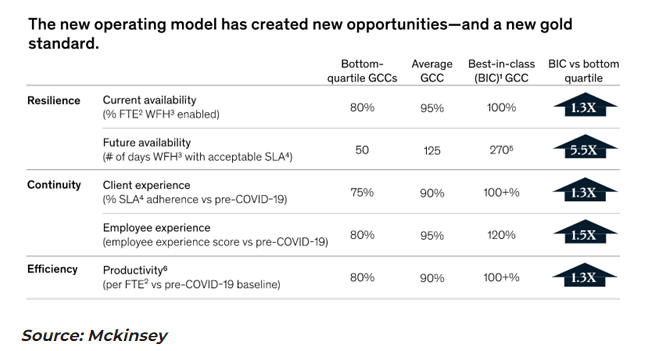
1. The KPIs Augmenting the Strategic Success of GCC Models
The global resonance of GCCs is further accentuated by their economic significance. Deloitte’s analysis prognosticates a potential growth trajectory scaling up to US$60–85 billion in the forthcoming years under various growth scenarios. These centers not only endow parent organizations with specialized capabilities but also harness the skilled workforce and cost efficiencies in India to propel economic prosperity and innovation.
1.1 Six Core Levers for Achieving Organizational Excellence in GCC
Let’s outline six critical strategies for enhancing organizational performance and effectiveness. These levers encompass global alignment, digital transformation, innovation, leadership development, and learning and development. By focusing on these core aspects, organizations can achieve excellence and drive sustainable growth.
1.1.1 Alignment with Global Strategy
Create processes, services, and delivery mechanisms that align with global objectives—and foster innovation within the organization to support these goals.
1.1.2 Value Journey Planning
Strengthen India’s capabilities, skills, and value-added programs. Aim to position India as a leading capability center globally or within the region.
1.1.3 Building the Digital Edge
Develop agile transformation capabilities in areas such as automation, AI/ML, and analytics.
1.1.4 Innovation Beyond the Obvious
Cultivate continuous, business-driven innovation that draws on expertise and adapts to changing needs.
1.1.5 Future-Ready Learning & Development (L&D)
Align L&D initiatives with global objectives. Transform India into a hub for exporting skills, emphasizing core leadership and talent development.
1.1.6 Local to Global Leadership
Promote leadership capabilities at the regional hub level and extend this influence globally through experiential enablement.
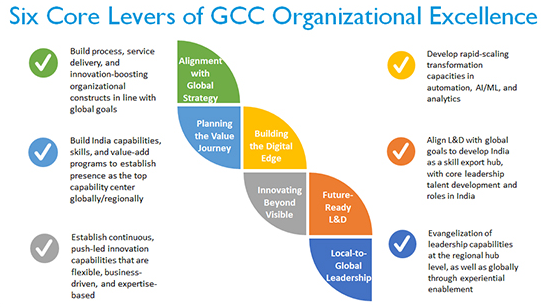
The Core Levers of GCC Organizational Excellence: Source: Nasscom
In essence, global capability centers stand as vanguards in spearheading global innovation, with a strategic emphasis on technology enablement, talent incubation, and collaborative synergies. Their trajectory of growth and impact on the industry underscores their indispensable role in sculpting the contours of future business operations and digital metamorphosis on a global canvas.
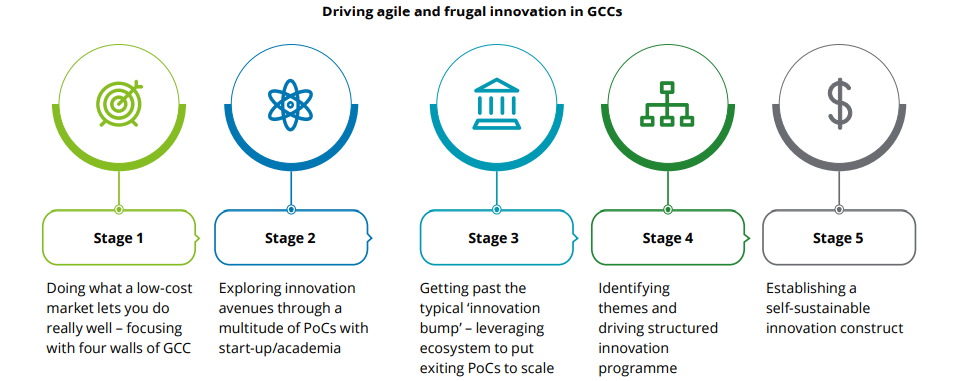
How GCCs Drive Innovation: Source: Nasscom
2. Evolutionary Phases of Global Capability Centers (GCCs)
During the early days of Global Capability Centers (GCCs) in the 1980s, organizations sought ways to trim operational expenses for critical functions such as IT upkeep, customer support, and financial operations.
Pioneering entities strategically positioned their GCCs in offshore havens like India, the Philippines, Poland, China, and Mexico to tap into the abundant talent pool available at more economical rates. As the 1990s unfolded, an escalating number of enterprises established GCCs dedicated to call centers, IT infrastructure oversight, and fundamental finance and accounting tasks.

Why India Pioneers the Global GCC Sphere; Source: Draup
With the passage of time, the realm of GCC operations transcended mundane chores, delving into more intricate endeavors. Companies came to a profound realization that offshore resources were adept at handling tasks far beyond the realm of routine assignments.
Hubs such as India boasted a wealth of proficient individuals, including developers, analysts, researchers, accountants, and technicians – all at a fraction of the expenditure incurred in developed nations. GCCs swiftly burgeoned as multinational corporations bolstered their proficiencies in software development, data analytics, equity analysis, financial modeling, and other sophisticated realms of work.
The evolution of Global Capability Centers (GCCs) can be summarized into three distinct phases:
2.1 Initial Phase:
GCCs commenced their journey by generating value primarily through the execution of operational tasks.
They primarily served as centers for back-office functions, corporate business support, and contact centers.
Their responsibilities encompassed IT support activities such as application development, maintenance, remote IT infrastructure management, and help desks.
2.2 Second Phase:
In this phase, GCCs extended their value proposition beyond mere execution.
They shifted their focus towards enhancement, striving to become centers of excellence for automation, innovation, and analytics.
The location-based model for GCCs, established before the crisis, flourished during this phase.
Third Phase:
GCCs underwent further evolution, aiming to deliver value through a holistic approach encompassing execution, enhancement, and innovation.
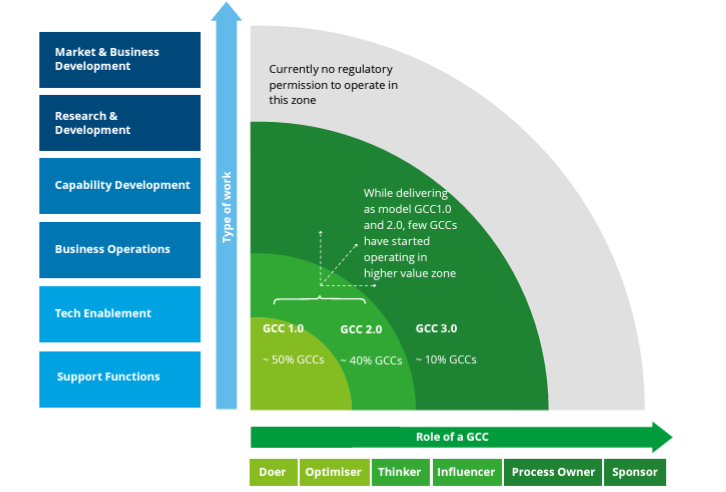
The Evolution of GCCs; Source: Deloitte
2.3 Evolving as Vanguard Innovators and Global Value Organizations
2.3.1 Strategic Focus Areas
- Digital Transformation Initiatives: Embracing technology to drive efficiency and foster growth across geographical boundaries.
- Talent Cultivation Ecosystem: Nurturing a cadre of skilled professionals equipped to meet the demands of dynamic industries.
- Collaborative Partnerships: Building alliances and promoting knowledge exchange for sustained innovation and growth.
- Unveiling Operational Resilience: In the face of the challenges posed by the COVID-19 pandemic, GCCs displayed unparalleled agility by swiftly transitioning to remote work environments without compromising service excellence. As pillars of resilience, continuity, and effectiveness, leading GCCs weathered the storm and set a high watermark for operational brilliance. This journey of metamorphosis cements the pivotal role played by GCCs as irreplaceable engines of innovation and architects shaping the future of work.
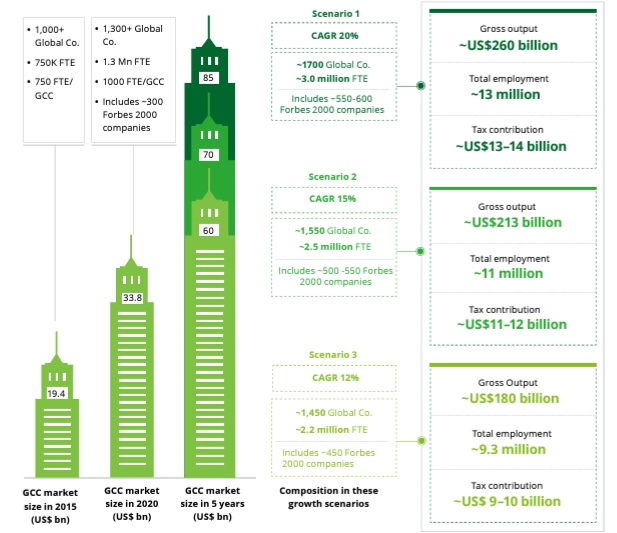
GCC: Growth Scenarios and Impact; Source: Deloitte
2.4 Nurturing Global Value Organizations: Drivers and Benefits
Over the course of the next half-decade, commencing in 2021, the GCC sector harbors the immense potential to experience substantial growth, with projections reaching an impressive scale of US$60–85 billion under various growth scenarios. This expansion not only promises far-reaching economic implications for the country but also encompasses significant facets spanning human capital, ecosystem development, social progress, and reputation enhancement.
2.4.1 Evolution into Unified Global Services
Instead of existing as siloed offshore entities, GCCs have metamorphosed into fully-fledged Global Value Organizations (GVOs), seamlessly integrating services across various locations with a sharper focus on advanced offerings surpassing rudimentary duties.
2.4.2 Fostering Talent and Expertise
The reservoir of offshore talent has been enriched with specialized proficiencies in domains such as risk assessment, data analytics, engineering, and logistics, empowering them to act as enablers of enterprise elevation and inventive breakthroughs.
2.4.3 Visionary Leadership
Leaders at the helm of eminent GVOs have pivoted towards broadening their horizons from a cost-centric mentality to championing innovation, client insights, and end-to-end process ownership.
2.4.4 Leveraging Technology Advancements
Harnessing the power of cutting-edge global connectivity, cloud infrastructures, and collaborative platforms, GVOs seamlessly function across geographical landscapes, transcending boundaries for streamlined operations.
2.4.5 Strategic Windfalls of GVO Transition
Forward-thinking corporations have reaped tangible rewards through the progression of their GCCs into robust GVOs:
- Savings with a Dash of Innovation: GVOs drive operational efficiencies via impeccable processes while also fueling new product ideation and Intellectual Property (IP) generation, resulting in cost savings ranging from 25% to 40%.
- Insight-rich Environment: By taking charge of core operational functions, GVOs craft data-powered insights for business units using discerning analytics.
- Talent Magnetism: GVOs possess a magnetic appeal, attracting and nurturing specialized talent that seamlessly enhances innovation centers and research and development (R&D) labs across the global landscape.
- Enhanced Business Agility: GVOs elevate business agility by orchestrating processes harmoniously across multiple locations, ensuring seamless coordination and 24×7 service delivery.
- Seizing the Future: In this rapidly evolving business landscape, GVOs stand poised to shape the trajectory of innovation and value creation in an interconnected world. Through their strategic focus areas of digital transformation, talent cultivation, and collaborative partnerships, GVOs are reshaping the way organizations operate and respond to ever-changing market demands.
With an unwavering commitment to operational excellence, GVOs drive not only cost savings but also foster innovation, generate meaningful insights, and attract top-tier talent. By leveraging technology advancements, these organizations seamlessly execute complex operations across borders, drawing upon a vast pool of specialized expertise.
As the world continues to transform, GVOs will play an increasingly integral role in building agile, resilient, and globally connected organizations. Embracing the vision of becoming strategic global value organizations, these entities embody the future of business operations, innovation, and sustainable growth.
3. India’s Ascendance as a Premier Hub for Global Capability Centers: A Comprehensive Exploration of Its Allure
India, with its kaleidoscope of culture, history, and ingenuity, has ascended as a juggernaut in the global domain of Global Capability Centers (GCCs). These centers, also known as shared services centers, captive centers, or offshore delivery centers, stand as linchpins in shaping the trajectory of work dynamics worldwide. India’s ascent as a GCC hub transcends mere cost considerations; it epitomizes value creation in its purest essence.
Organizations recognize India’s capacity to offer more than just operational efficiency—it serves as a fertile ground for innovation, talent cultivation, and strategic alliances. As the world continues to evolve, India’s GCCs remain at the forefront, bridging continents and propelling progress into uncharted territories.
India has firmly established itself as the global hub for Global Capability Centers (GCCs), with Bengaluru leading the pack in platform engineering while Hyderabad emerges as a formidable contender.
A noticeable trend is the shift towards Tier-2 cities like Trivandrum, Coimbatore, Ahmedabad, Vadodara, and Jaipur, focusing on establishing Centers of Excellence (CoEs) or specialized capability centers. Pune and Chennai predominantly host automotive GCCs, whereas Mumbai is dominated by BFSI GCCs.
India’s unique advantage lies in its homogeneous pool of skilled talent across locations, enabling GCCs to diversify operations for risk mitigation and business continuity. Although primarily concentrated in major cities, GCCs are increasingly expanding to include tier-2 cities in their geographical footprint.


GCCs In India: Source: Deloitte
Let’s embark on a journey to unearth why India shines brightly as a magnet for GCCs:
3.1 Abundance and Excellence in Talent:
India boasts an expansive reservoir of skilled professionals across diverse disciplines.
Its robust education ecosystem churns out graduates proficient in engineering, technology, finance, and other pivotal fields.
The prevalence of an English-speaking workforce facilitates seamless global communication.
GCCs in India leverage this talent pool, fostering growth through continuous learning and upskilling initiatives.
3.2 Cost Efficiency and Operational Brilliance:
India’s allure remains bolstered by significant cost arbitrage opportunities. Labor expenses in India stand notably lower than those in developed nations.
GCCs thrive on operational prowess, streamlined processes, and the advantages of scale.
Outsourcing non-core functions to India enables organizations to sharpen their focus on core competencies, thereby enhancing overall operational efficiency.
3.3 Robust Infrastructure and Seamless Connectivity:
- India’s digital infrastructure has witnessed remarkable evolution and growth.
- High-speed internet connectivity, dependable power supply, and state-of-the-art facilities underpin seamless operations.
- Well-connected airports and ports facilitate global collaboration, further enhancing India’s appeal as a GCC destination.
3.4 Governmental Support and Regulatory Facilitation:
- The Indian government proactively champions GCCs through conducive policies and incentivization measures.
- Single-window clearances, tax benefits, and regulatory ease serve as catalysts for foreign investment.
- Flagship initiatives like Digital India and Make in India foster an ecosystem conducive to the growth and sustenance of GCCs.
3.5 Diverse Industry Verticals and Expertise:
India’s GCC landscape traverses a myriad of sectors, encompassing:
- Pioneering IT services, software development, and digital transformation in the Information Technology (IT) sector.
- Back-office operations, risk management, and analytics in Banking, Financial Services, and Insurance (BFSI).
- Driving research, data analytics, and telemedicine in Healthcare and Life Sciences.
- Innovation across domains in Engineering and Research & Development (R&D).
- Managing supply chains, customer support, and analytics in Retail, Consumer Goods, and E-commerce.
3.6 Innovation and Collaborative Synergies:
- GCCs serve as avant-garde in catalyzing global innovation.
- They incubate disruptive ideas, spearhead the adoption of emerging technologies, and propel digital transformation.
- Collaborative partnerships with local universities, startups, and industry bodies foster a robust ecosystem for knowledge exchange and ideation.
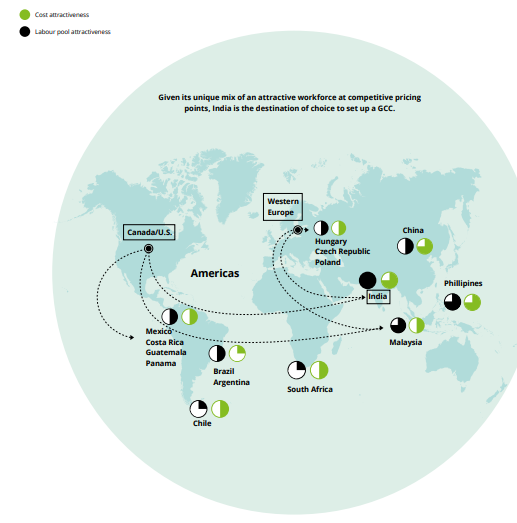
India as the Hub of Global Capability Center: Source: Deloitte
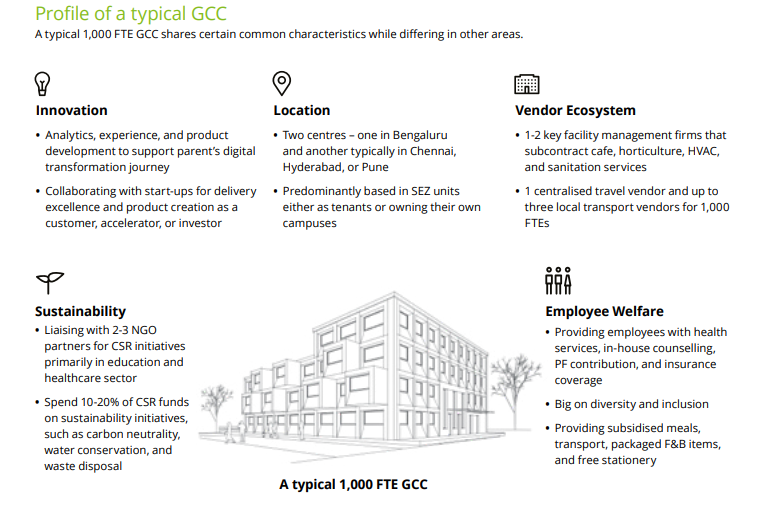
India as the Hub of Global Capability Center: Source: Deloitte
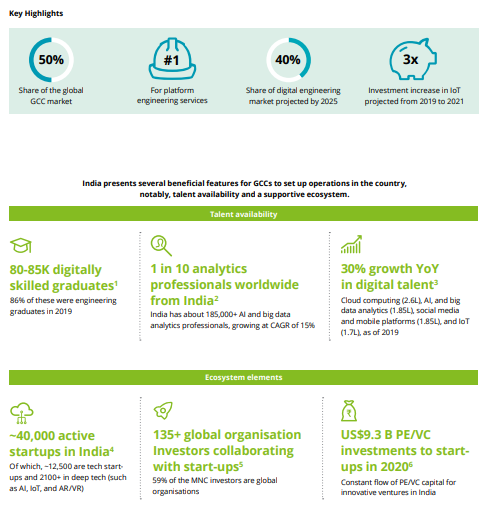
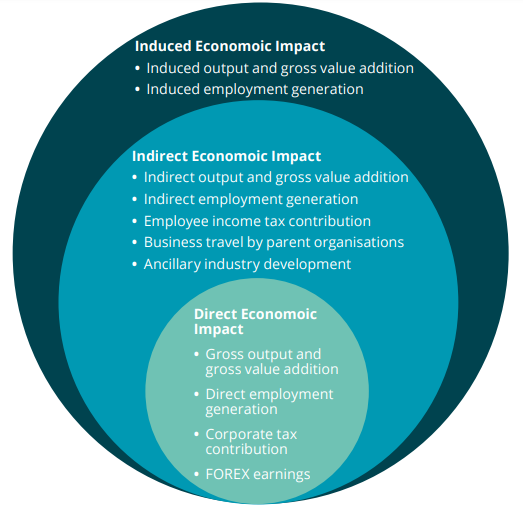
Key Highlights of Global GCCs and Their Induced Economic Impact: Source: Deloitte
4. Exploring the Transformative Power of Global Capability Centers (GCCs): Case Studies and Breakthroughs in Technology and Product Development
Let’s delve into the fascinating world of Global Capability Centers (GCCs) and their pivotal role in driving innovation and breakthroughs on a global scale. These centers, often nestled in various corners of the world, serve as dynamic hubs where technology, talent, and creativity converge.

India Pioneering the GCC Ecosystem: Source: POLESTAR
Buckle up as we explore real-life examples and use cases that exemplify the transformative impact of GCCs:
4.1 Retail Revolution from India:
Scenario: A global retail giant establishes its GCC in India.
Use Case: The Indian GCC becomes the technology headquarters for international product development. Key innovations originating from India are seamlessly launched in several Latin American countries. This exemplifies how GCCs can drive cross-border impact by spearheading e-commerce platform development and product enhancements.
4.2 Healthcare Innovations:
Scenario: Healthcare companies across the value chain (payers, providers, and pharma giants) set up GCCs in India.
Use Case: These GCCs may not create entirely new technology innovations, but they excel at applying breakthroughs to practical business scenarios. For instance, one Global Captive Center manages over 700,000 digital twins, resulting in a staggering $300 million in productivity improvements for their parent company.
4.3 Collaboration with Global Universities:
Scenario: Indian GCCs actively collaborate beyond borders.
Use Case: A retail GCC partners with MIT professors to develop algorithms that enhance store portfolio management. This exemplifies how GCCs leverage global expertise to drive innovation and efficiency.
4.4 GCCs as Global Growth Engines:
Scenario: India’s GCCs are at the forefront of the GCC 4.0 wave.
Use Case: These centers go beyond cost and scale considerations. They contribute to solving complex business and technology challenges for their headquarters. By fostering multi-function efficiencies, creating new product lines, and embracing global roles, GCCs redefine the blueprint of globalization.
4.5 Strategic Innovation in GCCs:
Scenario: Organizations seek to foster innovation within their GCCs.
Use Case: GCCs become critical differentiators, enabling competitive advantages and resilience against disruptions. Crafting robust strategies for innovation within these centers drives outcomes at scale. They serve not only as technology and innovation sandboxes but also as incubators for global leadership.
In essence, Indian GCCs have evolved from cost-saving entities to powerful engines of global progress. Their impact extends far beyond national boundaries, shaping the future of technology, products, and business worldwide.
5. Navigating the Path to Excellence: Strategic Considerations for Establishing a Global Capability Center (GCC) Powered by MSys CoEs (Centers of Excellence)
Certainly! Let’s delve into the strategic considerations when establishing your own Global Capability Center (GCC) and explore how MSys CoEs (Centers of Excellence) can play a pivotal role in elevating your organization to a “Global Value Organization” (GVO).
5.1 Strategic Considerations for Establishing a GCC:
5.1.1 Product Development and Management:
- Advanced Product Innovation and Lifecycle Management
- Superior Product Strategy and Roadmap Execution
- Streamlined Product Development Processes
- Enhanced Product Quality Assurance and Testing
- Agile Product Management Methodologies
- Robust Product Portfolio Optimization
- Efficient Resource Allocation and Capacity Planning
- Innovative Product Design and Conceptualization
- Effective Cross-functional Collaboration for Product Success
- Continuous Market Research and Product Evolution
- Seamless Integration of Customer Feedback into Product Development
- Data-driven Decision Making for Product Enhancements
- Agile Prototyping and Rapid Iteration Processes
- Scalable Product Scalability Strategies
5.1.2 Business Objectives and Alignment:
- Leading GCCs now focus on value creation beyond costs.
- Strategic Tech Stack Management for Enhanced Product Development
- Integration of Cutting-edge Technologies for Product Innovation
- Alignment of Tech Stack with Business Objectives for Optimal Performance
- Continuous Evaluation and Optimization of Tech Stack for Efficiency
- Implementation of Agile Tech Stack Solutions for Rapid Development and Adaptation
- Define clear business objectives for your GCC. Align them with the organization’s overall strategy. Consider innovation, digital transformation, and revenue growth as key drivers.
5.1.3 Talent Pool and Cost Arbitrage:
- GCCs have evolved beyond mere cost savings. The rich talent pool in India has made them integral to long-term strategies for corporations worldwide.
- Assess the availability of skilled talent in the chosen location. India, with its diverse talent base, remains a top choice for GCCs. Evaluate the cost arbitrage benefits while ensuring access to specialized skills.
5.1.4 Operational Flexibility and Control:
- Captive centers offer flexibility and control.
Understand the level of control you need. Captive centers allow customization, agility, and direct management. Evaluate the trade-offs against outsourcing.
5.1.5 Ecosystem Partnerships:
- Ecosystem partners specialize in turn-key captive setups.
Leverage partners who provide end-to-end solutions. These “virtual captives” simplify the process, eliminating the need for complex local expertise.
5.1.6 Risk Assessment and Mitigation:
- Identify risks associated with regulatory compliance, talent retention, geopolitical factors, and operational disruptions. Develop robust risk mitigation strategies.
5.2 MSys CoEs: Elevating to Global Value Organizations (GVOs):
5.2.1 Domain Expertise:
- MSys CoEs specialize in specific domains (such as AI/ML, IoT, and digital services). Leverage this expertise to align your GCC’s focus with industry trends and emerging technologies.
5.2.2 Technology Leverage:
- CoEs drive innovation by staying at the forefront of technology. They provide insights, best practices, and R&D support. Collaborate with CoEs to enhance your GCC’s capabilities.
5.2.3 Talent Depth and Skill Enhancement:
- CoEs nurture talent through continuous learning and skill development. They bridge the gap between theoretical knowledge and practical application. Invest in upskilling programs for your GCC team.
5.2.4 Integrated Solutions:
- CoEs enable end-to-end solutions. Integrating digital services, AI/ML and IoT capabilities enhance your GCC’s value proposition.
5.2.5 Strategic Advantages Beyond Costs:
- CoEs contribute to strategic advantages. They drive efficiency, quality, and innovation. Collaborate with CoEs to create a holistic roadmap for your GCC’s growth.
Concluding
Closing the book on GCCs, establishing a GCC requires thoughtful planning, alignment with business goals, and leveraging specialized expertise. MSys CoEs can be your compass, guiding your GCC toward becoming a Global Value Organization that transcends cost-centric models and embraces strategic impact.
